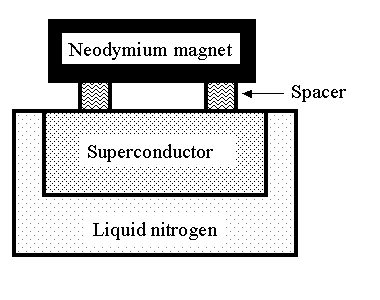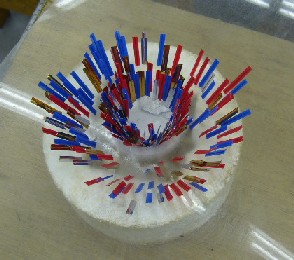2010/04/18:revised
2009/10/09:revised
2008/11/04:revised
2008/05/24
Paper
Preprint
Observation of Superconductivity
Yoshihiko Saito
Osaka Science Museum
Magnet floating above a superconductor. A high-temperature superconductor
(HTS) is cooled in liquid nitrogen and repels a neodymium ring magnet.
The horizontal movement of the magnet is controlled by a pair of chopsticks.
Though it is often explained that this is the Meissner effect, this statement
is not correct. Meissener effect is the phenomenon that the magnetic field
lines are excluded from a superconductivity object. The repulsion of the
magnet is why the magnetic field lines of the magnet are removed from the
superconductor.
Let's observe the repulsion of the magnetic field lines.
The superconductor is put in this magnetic field. This magnet is a 100mm
cubic neodymium magnet of mgnetic flux dencity about 0.5T at the surface.
It can be seen clearly that the magnetic field lines can not penetrate
and avoid the superconductor.
Movie
It cannot be claimed that the repulsion are caused by the Meissner effect,
because the repulsion by the Meissner effect can be seen up to about 10-20
mT, which is lower than the external field by the 100mm cubic neodymium
magnet. The powerful repulsion is caused by the pinning effect.
If the superconductor is cooled as follows

then
the superconductor is bound to a neodymium ring magnet (the held black
object) at a fixed distance for the pinned effect.
Movie1 Movie2
Let's put this superconductor above the 100mm cubic neodymium magnet.

It can be seen that the magnetic field lines of the ring-shaped neodymium magnet have been transplanted.
Movie1 Movie2 Movie3 Movie4
Let't move the HTS in in the horizontal direction.
The magnetic field lines cannot be moved in the HTS. This is the very the
pinning effect.
Movie
What will happen if the superconductor is warmed in the room temperature?
Movie1 Movie2
Science Show
Magnetic Field and Superconductivity
Paper
Preprint
Acknowledgments
The author thanks Nippon Steel Corporation for supply of the superconductor.